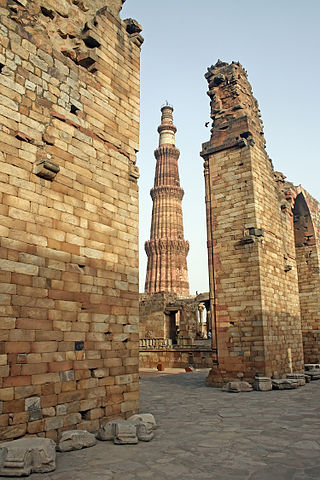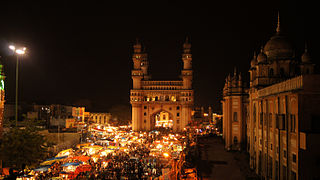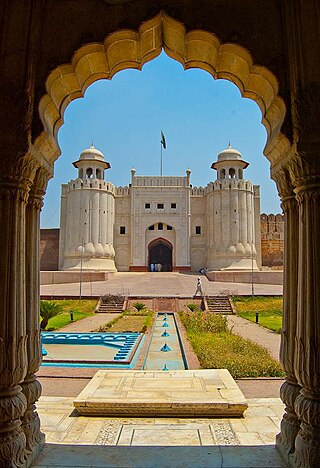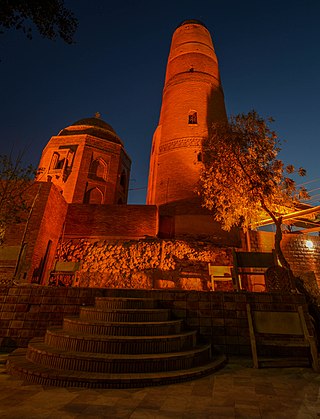
Mir Masum Minar, known locally as Masum Shah jo Minaro, is a monument in Sukkur, Pakistan. Built during the Mughal period, it is a high minaret of Mir Masum Shah.

Mir Masum Minar, known locally as Masum Shah jo Minaro, is a monument in Sukkur, Pakistan. Built during the Mughal period, it is a high minaret of Mir Masum Shah.
The minaret is built of burned bricks. It stands about 34 metres (112 ft) high and stretches 28 metres (92 ft) in circumference at the base. It is surmounted by a dome reached by an internal staircase. [1] The minaret was started in 1595 AD by Mir Muhammad Masum Shah Bakhri and completed by his son, Mir Buzurg in 1618 AD. [2]

The monument was built to honor Mir Masum, who was a scholar, poet, calligraphist, historian, and soldier. [3] [4] [5] Mir Masum was born at Sukkur-Bhakkar in 944 AH (1537 AD). He wrote a history of Sindh called the Tarikh-e-Masumi, compiled in 1009 AH (1600 AD). His services and qualities impressed Emperor Akbar who awarded him large jagirs in the surrounding areas of Sukkur. In 1606 AD, he was bestowed with the title of Amin-ul-Maulk by Emperor Jahangir. [6] [7]

The Taj Mahal is an ivory-white marble mausoleum on the right bank of the river Yamuna in Agra, Uttar Pradesh, India. It was commissioned in 1631 by the fifth Mughal emperor, Shah Jahan to house the tomb of his beloved wife, Mumtaz Mahal; it also houses the tomb of Shah Jahan himself. The tomb is the centrepiece of a 17-hectare (42-acre) complex, which includes a mosque and a guest house, and is set in formal gardens bounded on three sides by a crenellated wall.

Bukhara is the seventh-largest city in Uzbekistan by population, with 280,187 residents as of 1 January 2020. It is the capital of Bukhara Region. The mother tongue of the majority of people of Bukhara is the Tajik dialect of the Persian language, although Uzbek is spoken as a second language by most residents.

Hyderabad is a city and the capital of Hyderabad Division in the Sindh province of Pakistan. It is the second-largest city in Sindh, and the fifth largest in Pakistan.

The Qutb Minar complex are monuments and buildings from the Delhi Sultanate at Mehrauli in Delhi, India. Construction of the Qutub Minar "victory tower" in the complex, named after the religious figure Sufi Saint Khwaja Qutbuddin Bakhtiar Kaki, was begun by Qutb-ud-din Aibak, who later became the first Sultan of Delhi of the Mamluk dynasty. It was continued by his successor Iltutmish, and finally completed much later by Firoz Shah Tughlaq, a Sultan of Delhi from the Tughlaq dynasty (1320–1412) in 1368 AD. The Qubbat-ul-Islam Mosque, later corrupted into Quwwat-ul Islam, stands next to the Qutb Minar.

Minar-e-Pakistan is a tower located in Lahore, Punjab, Pakistan. The tower was built between 1960 and 1968 on the site where the All-India Muslim League passed the Lahore Resolution on 23 March 1940 – the first official call for a separate and independent homeland for the Muslims of British India, as espoused by the two-nation theory. The resolution eventually helped lead to the creation of Pakistan in 1947.
The Qutb Minar, also spelled Qutub Minar and Qutab Minar, is a minaret and "victory tower" that forms part of the Qutb complex, which lies at the site of Delhi's oldest fortified city, Lal Kot, founded by the Tomar Rajputs. It consists of 399 steps It is a UNESCO World Heritage Site in the Mehrauli area of South Delhi, India. It is one of the most visited tourist spots in the city, mostly built between 1199 and 1220.

The Charminar is a monument located in Hyderabad, Telangana, India. Constructed in 1591, the landmark is a symbol of Hyderabad and officially incorporated in the emblem of Telangana. The Charminar's long history includes the existence of a mosque on its top floor for more than 425 years. While both historically and religiously significant, it is also known for its popular and busy local markets surrounding the structure, and has become one of the most frequented tourist attractions in Hyderabad. Charminar is also a site of numerous festival celebrations, such as Eid-ul-adha and Eid al-Fitr, as it is adjacent to the city's main mosque, the Makkah Masjid.

Sukkur is a city in the Pakistani province of Sindh along the western bank of the Indus River, directly across from the historic city of Rohri. Sukkur is the third largest city in Sindh after Karachi and Hyderabad, and 14th largest city of Pakistan by population. The city was originally founded by the Rai dynasty of Sindh. The modern city was built in the 1840s. New Sukkur was established during the British era alongside the village of Sukkur. Sukkur's hill, along with the hill on the river island of Bukkur, form what is sometimes considered the "Gate of Sindh".

Khairpur is a city and the capital of the Khairpur District of Pakistan's Sindh province.

Khairpur District is a district in the Pakistani province of Sindh in Sukkur Division.

Mughal architecture is the type of Indo-Islamic architecture developed by the Mughals in the 16th, 17th and 18th centuries throughout the ever-changing extent of their empire in the Indian subcontinent. It developed from the architectural styles of earlier Muslim dynasties in India and from Iranian and Central Asian architectural traditions, particularly Timurid architecture. It also further incorporated and syncretized influences from wider Indian architecture, especially during the reign of Akbar. Mughal buildings have a uniform pattern of structure and character, including large bulbous domes, slender minarets at the corners, massive halls, large vaulted gateways, and delicate ornamentation; examples of the style can be found in modern-day Afghanistan, Bangladesh, India and Pakistan.

Indo-Islamic architecture is the architecture of the Indian subcontinent produced by and for Islamic patrons and purposes. Despite an initial Arab presence in Sindh, the development of Indo-Islamic architecture began in earnest with the establishment of Delhi as the capital of the Ghurid dynasty in 1193. Succeeding the Ghurids was the Delhi Sultanate, a series of Central Asian dynasties that consolidated much of North India, and later the Mughal Empire by the 15th century. Both of these dynasties introduced Islamic architecture and art styles from West Asia into the Indian subcontinent.

Chauburji is a Mughal era monument in the city of Lahore, capital of the Pakistani province of Punjab. The monument was built in 1646 C.E. during the reign of the emperor Shah Jahan. It previously acted as a gateway to a large garden. Hockey legend, Zahid Shareef was also born in Rajgarh Chauburji.

This article is about Hiran Minar at Sheikhupura, Pakistan; For Hiran Minar at Fatehpur Sikri, India, see Fatehpur Sikri.

Tourism in Pakistan is a growing industry. In 2010, Lonely Planet termed Pakistan "tourism's 'next big thing'". The country is geographically and ethnically diverse, and has a number of historical and cultural heritage sites. Condé Nast Traveller ranked Pakistan The Best Holiday Destination for 2020 and also declared it the third-highest potential adventure destination in the world for 2020. As security in the country improves, tourism increases; in two years, it has increased by more than 300%. The Pakistani government had launched online visa services for 175 countries and 50 countries were offered visa on arrival, making visiting Pakistan easier. The country received an influx of travel vloggers, who promoted the characteristics of the country, such as in the Northern Pakistan, like Hunza and Skardu.

Sateen Jo Aastan is located on the left bank of the Indus River near Rohri, Sindh, Pakistan. The place was named as “safae-e-safa” built by Mir Abu al Qasim Namkeen when he was the governor of the Bakhar. He used this great scenic place as cultural gathering place, particularly in full moon nights. Abu al Qasim died in 1018AH and his body was brought for burial from Kabul at this place. His son Mir Abu al Baqa Amir Khan died in 1057AH in Thatta and his body too was brought to bury here along with his father Abu al Qasim Namkeen.

Mir Muhammad Masoom Shah Bakhri, also known as Syed Nizamuddin Mir Muhammad Masoom Shah, was a sixteenth-century Sindhi Muslim historian from Bakhar, Sindh. He is known for writing a history of Sindh, Tarikh i Sind, published in ca. 1600. He was also a trusted lieutenant of the Mughal emperor Akbar. In around 1595, he led Akbar's army in a battle against the Panni Afghans stronghold of Sibi in northwest Quetta, resulting in Baluchistan being annexed into the Mughal empire. Subsequently, in 1598, he was appointed the governor of Sind and Sibi by Akbar.
Pakistani architecture is intertwined with the architecture of the broader Indian subcontinent. The major architectural styles popular in the past were Temple, Indo-Islamic, Mughal and Indo-Saracenic architecture, all of which have many regional varieties. With the beginning of the Indus civilization around the middle of the 3rd millennium BC, for the first time in the area which encompasses today's Pakistan an advanced urban culture developed with large structural facilities, some of which survive to this day. This was followed by the Gandhara style of Buddhist architecture that borrowed elements from Ancient Greece. These remnants are visible in the Gandhara capital of Taxila.

Persian Inscriptions on Indian Monuments is a book written in Persian by Dr Ali Asghar Hekmat E Shirazi and published in 1956 and 1958 and 2013. New edition contains the Persian texts of more than 200 epigraphical inscriptions found on historical monuments in India, many of which are currently listed as national heritage sites or registered as UNESCO world heritage, published in Persian; an English edition is also being printed.

The Mini Qutub Minar is a minaret tower in Hastsal village in Uttam Nagar, West Delhi, India. It was built in the 1650 by Mughal emperor, Shah Jahan near his hunting lodge in Hasthal. The three storeyed tower is 16.87 meters tall and stands on a raised octagonal platform. The minar is built with bricks and clad with red sandstone. The tower structure and design resembles the Qutub Minar of Delhi and was inspired by it.